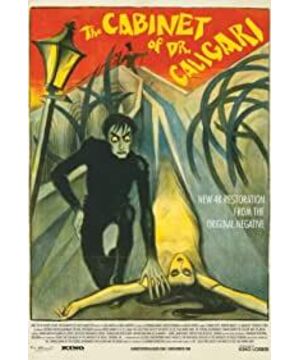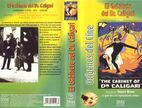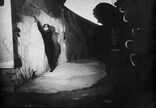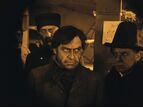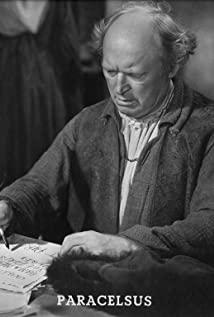Released in 1920, the film has always been a very classic German expressionist film masterpiece in major textbooks, and it is also one of the earliest suspense films in history.
Expressionist film is a trend of thought that emphasizes the artist's subjective feelings and self-feelings, leading to exaggeration, deformation and even grotesque processing of objective forms. Especially against the depiction of natural reality.
This film takes these characteristics of expressionism to the extreme.
The main actors appear in grotesque shapes, and their neurotic and exaggerated movements make the audience remember each character's idiosyncrasies. For example, the sullen Dr. Caligari, the mysterious and evil Caesar, the hysterical Jenny, and the only seemingly normal Francis.
The set has a strong surreal leanings. It is no exaggeration to say that almost every frame in the film is as beautiful as an oil painting. The scene is filled with a lot of triangular elements and many abstract elements with unclear meaning, which makes people feel depressed and weird. The director pays great attention to expressing atmosphere and mood through lines, shapes and colors. I remember a scene at the beginning. The sheriff was sitting on a one-meter-high stool in the police station. The doctor called him several times before the sheriff noticed the doctor. It seems to imply that in real social life, the sheriff sees himself as superior to others.
Even the actors are very particular about where they stand and how they act. In this scene of Jenny being kidnapped by Caesar, the actors' movements all imply a kind of beauty of painting.
All scenes have a total of three colors: yellow, green, and red. In the scene where Francis and the staff went to the doctor's office to find the diary at the end, after a staff member turned on the light, the scene changed from green to yellow. It is certain that yellow represents daytime and green represents night.
However, I feel that in a monochrome film, the distinction between day and night doesn't make much sense, and it doesn't affect the narrative. However, with the director's ultimate pursuit of aesthetics, it is impossible to use colors randomly. About two-thirds of the scenes in the film use yellow tones. Maybe yellow also represents Francis' fantasy world, and green represents the real world.
There are only two red scenes, both related to Francis' love for Jenny.
The graphics and character design of "Caligari" are particularly brilliant, but the structure and setting of the play are also worth scrutinizing. At present, most of the similar articles I see are interpreted from the height of expressionist art, but I want to interpret it from the perspective of literary fiction. The first is the conclusion. This movie has put the mystery novel on the screen, laying the foundation for future suspense and reasoning movies.
The story is divided into five acts.
Act 1: Introduce the background of the story and create suspense. Dr. Caligari wanted to participate in the garden party display. The host asked him what he wanted to show. Caligari gave an unexpected answer and wanted to show a sleepwalker.
Act 2: Begin to join the branch - the mayor is killed. Meanwhile, Caligari does show the sleepwalker, Caesar, who has been dormant for more than two decades at the garden party. Caesar, who was awakened in public, gave Alan a divination. Alan jokingly asked himself when he would die, and Caesar actually said that he would only live until dawn. The suspense has escalated to the point that someone may be threatened with life. The audience looks forward to seeing whether Alan will die next, and then watch the decryption process. Although this is a very common suspense technique in modern times, it also had a strong impact and a sense of horror at the time.
Act Three: The next morning, Alan was killed in his bedroom as prophesied. Companion Francis suspects that Dr. Caligari is the culprit. At this time, the police caught the murderer of the mayor and announced that he was the murderer of Alan. Reversing into suspense and horror movies is a common method. By creating various reversals, the story is more complicated and confusing, making full use of the curiosity of the audience, wanting to know what is going on, and keep watching.
Act Four: Francis still suspects Caligari and spy on his cabin. On the other side, Jenny was forcibly taken away by Caesar in her sleep. Fortunately, everyone came in time to save Jenny. At this time, Francis actually became a powerful witness to the evidence of Caesar's alibi.
Act V: This incident is obviously inseparable from the Doctor and Caesar, and a group of people went to the hut to catch the Doctor. The doctor took the opportunity to escape, and Francis chased the doctor to the mental hospital. At this time, the story has progressed to the later stage, and there is another reversal. The doctor is likely to be a mental patient, and Caesar's ability to predict is just a cover for his murder. Sure enough, a group of people found his doctor's diary, which wrote a detailed murder plan, just to prove whether he could instigate sleepwalkers to kill. This seemingly impossible and abnormal plan, which reinforces the suggestion that the Doctor is a mental patient, is actually the foreshadowing of the next scene.
The picture returns to the scene where Francis was chatting with a man at the beginning. Subsequently, the man accompanies Francis to the mental hospital. The picture gives a fixed panoramic camera position, and we can see that all the characters who have appeared before are standing or sitting in the yard of the mental hospital in a mental state that is obviously different from ordinary people. When the Doctor appears, viewers will find Caligari revamped from his scruffy image and dressed neatly. It turns out that Francis is the mental patient and Dr. Caligari is his delusion.
One of the scenes is very interesting. People took the mad Francis to the place where the "mad" doctor was once imprisoned. The camera was placed in the same position to capture a similar scene, which can not help but create an illusion of deja vu. Generally speaking, camera shots are objective, but this film sets them as subjective shots to mislead the audience. Because the audience believed the camera before and suspected Caligari to be a lunatic. Now that viewers know the camera can deceive people, is the truth now being shown real? It is also possible that Francis is the normal person.
In fact, this type of routine has already appeared in Benge mystery novels, and Edogawa Ranpo is a master of reversing tricks. First present a seemingly impossible, extremely bizarre event, and in the process of exploring the truth, reverse and then reverse to create a sense of surprise. For those who watch this genre for the first time, there is still a strong sense of impact. A masterpiece with a similar setting is the American film Shutter Island directed by Martin Scorsese, based on the novel of the same name. It is a pity that early films have not completely separated from the category of dramas and novels, especially silent films such as "Caligari". The narrative of the film cannot be completely expressed by pictures, and each scene needs to be dominated by novel-like words. Some scenes are also more like "indoor drama".
In addition to being amazed at the expressionist approach and repeatedly reversed ending of "Caligari", I am also very concerned about the truth of the matter. Francis may have actually killed a rival in love, maliciously removed his rival because of possessiveness, and suffered from schizophrenia as a result, put the responsibility and fault on others, and then claimed justice to arrest such a "criminal". How many such selfish people in real life are satirized. However, the crowd in the film only listened to what the person who mastered the speaker was saying, and no one cared about the truth. Francis said that the Doctor murdered, no one believed him, and said he was insane. When Francis tried to attack the Doctor, he was tied up and locked up. If you think about it, it is true, whether it is true or not, as long as people say it is true, then it is. Sooner or later, dissenting words will be buried in the torrent of time.
View more about The Cabinet of Dr. Caligari reviews


